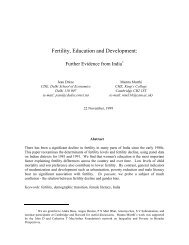You also want an ePaper? Increase the reach of your titles
YUMPU automatically turns print PDFs into web optimized ePapers that Google loves.
Pakistan in 1965, India’s external balances were under strain and the government<br />
was ready to entertain more contrived schemes to boost export earnings.<br />
coup was to persuade Pai in 1971 to authorise imports of polyester filament yarn<br />
(PFY) against exports of nylon fabric. Previously, nylon fabric exporters had earned<br />
some rights to replenish their stocks of nylon fibres through imports. Dhirubhai<br />
argued that if he could sell nylon or other manufactured textiles (known as ‘art silks’<br />
at Rs 4.25 a yard, more than double the price stipulated in the old scheme, the<br />
exporter should be rewarded by permission to import PFY, which was in greater<br />
domestic shortage because local production was far below demand.<br />
This resulted in what was called the Higher Unit Value Scheme, which made<br />
Dhirubhai a fortune while it lasted. At that time, the domestic price of PFY was seven<br />
or more times higher than the prevailing international price. Even if the nylon or<br />
polyester exports fetched only a quarter or one third of cost, this was more than<br />
offset by the 600 per cent or more profit on the PFY imports.<br />
Reliance went into a high-profile export drive, targeting some of the weaker<br />
economies of the world. Poland was one focus, with fashion shows mounted in<br />
Warsaw and delegations of Polish trade officials lavishly hosted by Dhirubhai in<br />
Bombay. Another was Saudi Arabia, where Dhirubhai had another old Aden colleague<br />
from Besse & Co’s Halal Shipping division, Bharat Kumar Shah, then working as a<br />
trader in Jeddah and acting as Reliance’s Mid-East Co-ordination manager’. Dhirubhai<br />
would take out full-page advertisements in <strong>The</strong> Times of India to announce special<br />
charter fights taking his export products to foreign markets.<br />
But many senior figures in the textile industry still believe this export business was<br />
mostly bogus. ‘f these goods were not saleable at two rupees, how could they sell at<br />
four rupees?’, one remarked. According to this theory, Dhirubhai would have<br />
provided his own export earnings, by sending the money out to the ostensible buyer<br />
overseas through the illegal foreign exchange channels known as havala (accepting<br />
the 20 per cent havala premium on the official exchange rate). <strong>The</strong> goods would be<br />
sent to a free port such as Singapore or Dubai, to avoid customs duty, and then he<br />
disposed of at giveaway prices, left to rot on the docks, or even dumped at sea. <strong>The</strong><br />
effective outgoings would be the 20 per cent havala premium on the funds sent out,<br />
and the 60 per cent of the same funds actually spent on buying PFY overseas for<br />
import back into India. <strong>The</strong> returns would be this 60 per cent multiplied by seven or<br />
more. <strong>The</strong> profit would be 425 per cent of the outlay. And as long as Dhirubhai had<br />
the ‘export remittance’s arriving back in his account in Bombay, he could claim credit<br />
for doing his bit for India’s trade balance.<br />
In an interview with the magazine Business India in April 1980, Dhirubhai said<br />
Reliance Commercial Corp accounted for more than 60 per cent of the exports made<br />
under the Higher Unit Value Scheme. ‘he schemes were open to everyone,’ he said.<br />
‘I cannot be blamed if my competitors were unenterprising or ignorant.’s Textile<br />
trade sources familiar with that era say this was not exactly the case. <strong>The</strong> adoption<br />
of the Higher Unit Value Scheme was not widely publicised in 197 1. Dhirubhai had a<br />
clear run of one or two years before other exporters began trying to take advantage<br />
of the same scheme, or putting up similar proposals for other categories of textile<br />
exports. One of these exporters, Bipin Kapadia, later recounted his experience to<br />
Bombay police who sought it as background to the sensational murder conspiracy<br />
case of 1989 (see Chapter 13).




